Stakeholder Engagement Strategies for Sydney Airport Runway Project
VerifiedAdded on 2023/06/04
|19
|5212
|136
Report
AI Summary
This report provides a detailed analysis of stakeholder engagement within the context of a runway project, specifically focusing on the Sydney Airport. The report begins by defining stakeholders and highlighting their importance in influencing project outcomes. It then explores the stakeholder engagement process, emphasizing the need for continuous communication, information dissemination, and the inclusion of all stakeholders. The report identifies key stakeholders, including government officials, the local community, suppliers, customers, and shareholders, and analyzes their interests and influence on the project. It examines the government's role in ensuring economic and safety standards, the community's concerns about land use and pollution, the suppliers' need for quality and timely payments, the customers' expectations for high-quality services, and the shareholders' financial interests. The report emphasizes the importance of stakeholder identification, communication, and management throughout the project lifecycle to ensure its success. It also outlines strategies for addressing potential conflicts and ensuring that all stakeholders have a voice in the project's development and implementation.
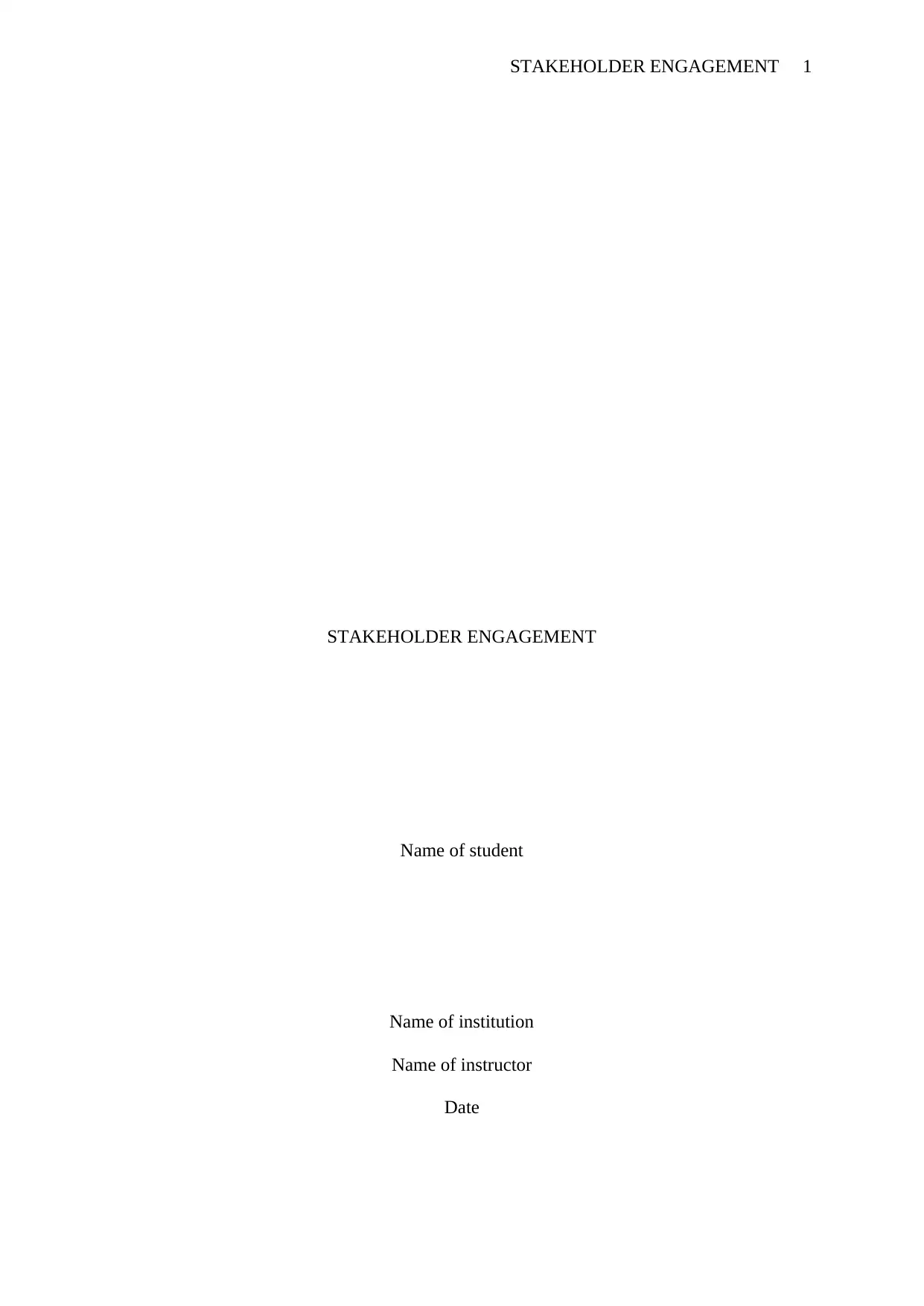
STAKEHOLDER ENGAGEMENT 1
STAKEHOLDER ENGAGEMENT
Name of student
Name of institution
Name of instructor
Date
STAKEHOLDER ENGAGEMENT
Name of student
Name of institution
Name of instructor
Date
Paraphrase This Document
Need a fresh take? Get an instant paraphrase of this document with our AI Paraphraser
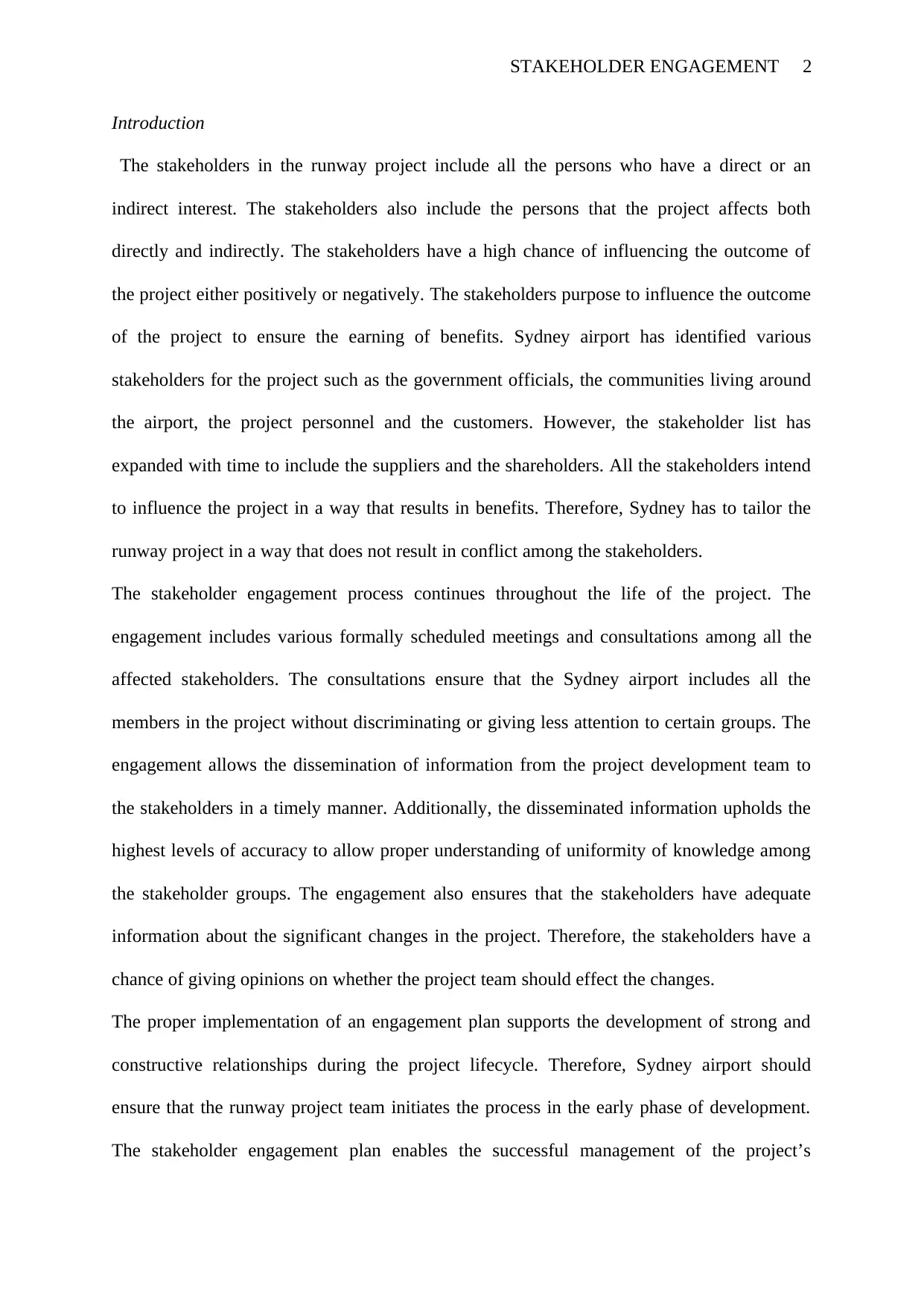
STAKEHOLDER ENGAGEMENT 2
Introduction
The stakeholders in the runway project include all the persons who have a direct or an
indirect interest. The stakeholders also include the persons that the project affects both
directly and indirectly. The stakeholders have a high chance of influencing the outcome of
the project either positively or negatively. The stakeholders purpose to influence the outcome
of the project to ensure the earning of benefits. Sydney airport has identified various
stakeholders for the project such as the government officials, the communities living around
the airport, the project personnel and the customers. However, the stakeholder list has
expanded with time to include the suppliers and the shareholders. All the stakeholders intend
to influence the project in a way that results in benefits. Therefore, Sydney has to tailor the
runway project in a way that does not result in conflict among the stakeholders.
The stakeholder engagement process continues throughout the life of the project. The
engagement includes various formally scheduled meetings and consultations among all the
affected stakeholders. The consultations ensure that the Sydney airport includes all the
members in the project without discriminating or giving less attention to certain groups. The
engagement allows the dissemination of information from the project development team to
the stakeholders in a timely manner. Additionally, the disseminated information upholds the
highest levels of accuracy to allow proper understanding of uniformity of knowledge among
the stakeholder groups. The engagement also ensures that the stakeholders have adequate
information about the significant changes in the project. Therefore, the stakeholders have a
chance of giving opinions on whether the project team should effect the changes.
The proper implementation of an engagement plan supports the development of strong and
constructive relationships during the project lifecycle. Therefore, Sydney airport should
ensure that the runway project team initiates the process in the early phase of development.
The stakeholder engagement plan enables the successful management of the project’s
Introduction
The stakeholders in the runway project include all the persons who have a direct or an
indirect interest. The stakeholders also include the persons that the project affects both
directly and indirectly. The stakeholders have a high chance of influencing the outcome of
the project either positively or negatively. The stakeholders purpose to influence the outcome
of the project to ensure the earning of benefits. Sydney airport has identified various
stakeholders for the project such as the government officials, the communities living around
the airport, the project personnel and the customers. However, the stakeholder list has
expanded with time to include the suppliers and the shareholders. All the stakeholders intend
to influence the project in a way that results in benefits. Therefore, Sydney has to tailor the
runway project in a way that does not result in conflict among the stakeholders.
The stakeholder engagement process continues throughout the life of the project. The
engagement includes various formally scheduled meetings and consultations among all the
affected stakeholders. The consultations ensure that the Sydney airport includes all the
members in the project without discriminating or giving less attention to certain groups. The
engagement allows the dissemination of information from the project development team to
the stakeholders in a timely manner. Additionally, the disseminated information upholds the
highest levels of accuracy to allow proper understanding of uniformity of knowledge among
the stakeholder groups. The engagement also ensures that the stakeholders have adequate
information about the significant changes in the project. Therefore, the stakeholders have a
chance of giving opinions on whether the project team should effect the changes.
The proper implementation of an engagement plan supports the development of strong and
constructive relationships during the project lifecycle. Therefore, Sydney airport should
ensure that the runway project team initiates the process in the early phase of development.
The stakeholder engagement plan enables the successful management of the project’s
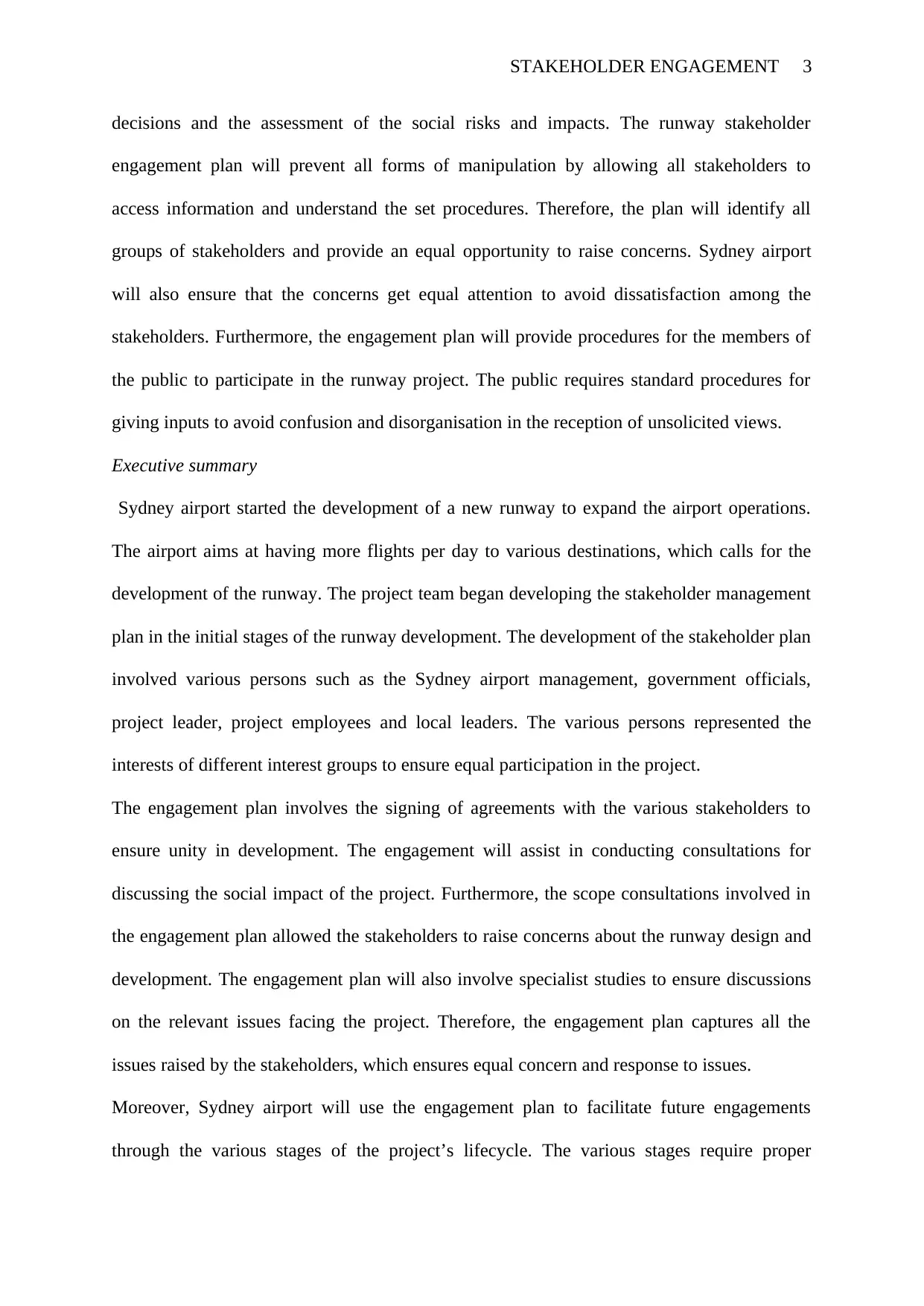
STAKEHOLDER ENGAGEMENT 3
decisions and the assessment of the social risks and impacts. The runway stakeholder
engagement plan will prevent all forms of manipulation by allowing all stakeholders to
access information and understand the set procedures. Therefore, the plan will identify all
groups of stakeholders and provide an equal opportunity to raise concerns. Sydney airport
will also ensure that the concerns get equal attention to avoid dissatisfaction among the
stakeholders. Furthermore, the engagement plan will provide procedures for the members of
the public to participate in the runway project. The public requires standard procedures for
giving inputs to avoid confusion and disorganisation in the reception of unsolicited views.
Executive summary
Sydney airport started the development of a new runway to expand the airport operations.
The airport aims at having more flights per day to various destinations, which calls for the
development of the runway. The project team began developing the stakeholder management
plan in the initial stages of the runway development. The development of the stakeholder plan
involved various persons such as the Sydney airport management, government officials,
project leader, project employees and local leaders. The various persons represented the
interests of different interest groups to ensure equal participation in the project.
The engagement plan involves the signing of agreements with the various stakeholders to
ensure unity in development. The engagement will assist in conducting consultations for
discussing the social impact of the project. Furthermore, the scope consultations involved in
the engagement plan allowed the stakeholders to raise concerns about the runway design and
development. The engagement plan will also involve specialist studies to ensure discussions
on the relevant issues facing the project. Therefore, the engagement plan captures all the
issues raised by the stakeholders, which ensures equal concern and response to issues.
Moreover, Sydney airport will use the engagement plan to facilitate future engagements
through the various stages of the project’s lifecycle. The various stages require proper
decisions and the assessment of the social risks and impacts. The runway stakeholder
engagement plan will prevent all forms of manipulation by allowing all stakeholders to
access information and understand the set procedures. Therefore, the plan will identify all
groups of stakeholders and provide an equal opportunity to raise concerns. Sydney airport
will also ensure that the concerns get equal attention to avoid dissatisfaction among the
stakeholders. Furthermore, the engagement plan will provide procedures for the members of
the public to participate in the runway project. The public requires standard procedures for
giving inputs to avoid confusion and disorganisation in the reception of unsolicited views.
Executive summary
Sydney airport started the development of a new runway to expand the airport operations.
The airport aims at having more flights per day to various destinations, which calls for the
development of the runway. The project team began developing the stakeholder management
plan in the initial stages of the runway development. The development of the stakeholder plan
involved various persons such as the Sydney airport management, government officials,
project leader, project employees and local leaders. The various persons represented the
interests of different interest groups to ensure equal participation in the project.
The engagement plan involves the signing of agreements with the various stakeholders to
ensure unity in development. The engagement will assist in conducting consultations for
discussing the social impact of the project. Furthermore, the scope consultations involved in
the engagement plan allowed the stakeholders to raise concerns about the runway design and
development. The engagement plan will also involve specialist studies to ensure discussions
on the relevant issues facing the project. Therefore, the engagement plan captures all the
issues raised by the stakeholders, which ensures equal concern and response to issues.
Moreover, Sydney airport will use the engagement plan to facilitate future engagements
through the various stages of the project’s lifecycle. The various stages require proper
⊘ This is a preview!⊘
Do you want full access?
Subscribe today to unlock all pages.

Trusted by 1+ million students worldwide
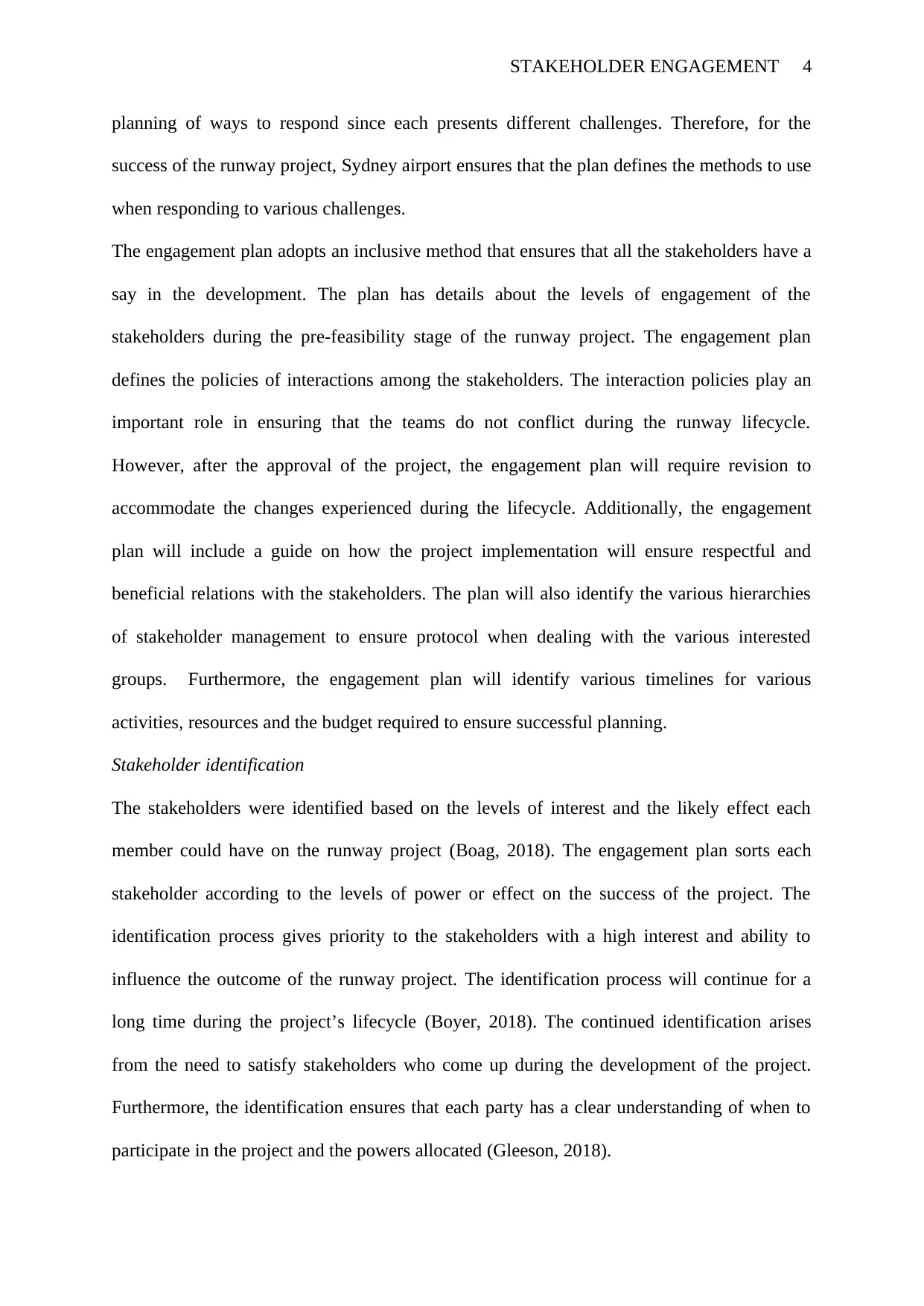
STAKEHOLDER ENGAGEMENT 4
planning of ways to respond since each presents different challenges. Therefore, for the
success of the runway project, Sydney airport ensures that the plan defines the methods to use
when responding to various challenges.
The engagement plan adopts an inclusive method that ensures that all the stakeholders have a
say in the development. The plan has details about the levels of engagement of the
stakeholders during the pre-feasibility stage of the runway project. The engagement plan
defines the policies of interactions among the stakeholders. The interaction policies play an
important role in ensuring that the teams do not conflict during the runway lifecycle.
However, after the approval of the project, the engagement plan will require revision to
accommodate the changes experienced during the lifecycle. Additionally, the engagement
plan will include a guide on how the project implementation will ensure respectful and
beneficial relations with the stakeholders. The plan will also identify the various hierarchies
of stakeholder management to ensure protocol when dealing with the various interested
groups. Furthermore, the engagement plan will identify various timelines for various
activities, resources and the budget required to ensure successful planning.
Stakeholder identification
The stakeholders were identified based on the levels of interest and the likely effect each
member could have on the runway project (Boag, 2018). The engagement plan sorts each
stakeholder according to the levels of power or effect on the success of the project. The
identification process gives priority to the stakeholders with a high interest and ability to
influence the outcome of the runway project. The identification process will continue for a
long time during the project’s lifecycle (Boyer, 2018). The continued identification arises
from the need to satisfy stakeholders who come up during the development of the project.
Furthermore, the identification ensures that each party has a clear understanding of when to
participate in the project and the powers allocated (Gleeson, 2018).
planning of ways to respond since each presents different challenges. Therefore, for the
success of the runway project, Sydney airport ensures that the plan defines the methods to use
when responding to various challenges.
The engagement plan adopts an inclusive method that ensures that all the stakeholders have a
say in the development. The plan has details about the levels of engagement of the
stakeholders during the pre-feasibility stage of the runway project. The engagement plan
defines the policies of interactions among the stakeholders. The interaction policies play an
important role in ensuring that the teams do not conflict during the runway lifecycle.
However, after the approval of the project, the engagement plan will require revision to
accommodate the changes experienced during the lifecycle. Additionally, the engagement
plan will include a guide on how the project implementation will ensure respectful and
beneficial relations with the stakeholders. The plan will also identify the various hierarchies
of stakeholder management to ensure protocol when dealing with the various interested
groups. Furthermore, the engagement plan will identify various timelines for various
activities, resources and the budget required to ensure successful planning.
Stakeholder identification
The stakeholders were identified based on the levels of interest and the likely effect each
member could have on the runway project (Boag, 2018). The engagement plan sorts each
stakeholder according to the levels of power or effect on the success of the project. The
identification process gives priority to the stakeholders with a high interest and ability to
influence the outcome of the runway project. The identification process will continue for a
long time during the project’s lifecycle (Boyer, 2018). The continued identification arises
from the need to satisfy stakeholders who come up during the development of the project.
Furthermore, the identification ensures that each party has a clear understanding of when to
participate in the project and the powers allocated (Gleeson, 2018).
Paraphrase This Document
Need a fresh take? Get an instant paraphrase of this document with our AI Paraphraser
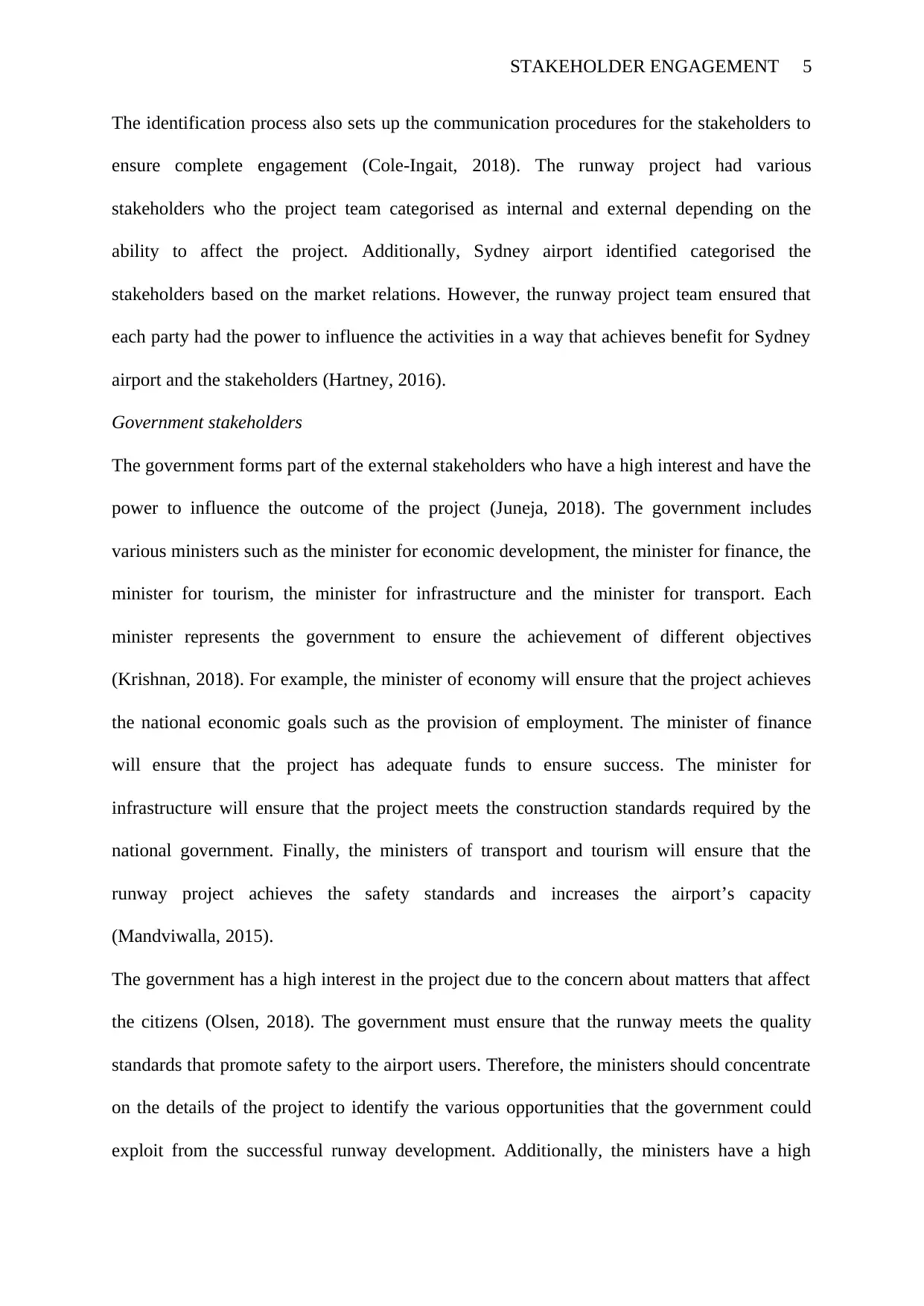
STAKEHOLDER ENGAGEMENT 5
The identification process also sets up the communication procedures for the stakeholders to
ensure complete engagement (Cole-Ingait, 2018). The runway project had various
stakeholders who the project team categorised as internal and external depending on the
ability to affect the project. Additionally, Sydney airport identified categorised the
stakeholders based on the market relations. However, the runway project team ensured that
each party had the power to influence the activities in a way that achieves benefit for Sydney
airport and the stakeholders (Hartney, 2016).
Government stakeholders
The government forms part of the external stakeholders who have a high interest and have the
power to influence the outcome of the project (Juneja, 2018). The government includes
various ministers such as the minister for economic development, the minister for finance, the
minister for tourism, the minister for infrastructure and the minister for transport. Each
minister represents the government to ensure the achievement of different objectives
(Krishnan, 2018). For example, the minister of economy will ensure that the project achieves
the national economic goals such as the provision of employment. The minister of finance
will ensure that the project has adequate funds to ensure success. The minister for
infrastructure will ensure that the project meets the construction standards required by the
national government. Finally, the ministers of transport and tourism will ensure that the
runway project achieves the safety standards and increases the airport’s capacity
(Mandviwalla, 2015).
The government has a high interest in the project due to the concern about matters that affect
the citizens (Olsen, 2018). The government must ensure that the runway meets the quality
standards that promote safety to the airport users. Therefore, the ministers should concentrate
on the details of the project to identify the various opportunities that the government could
exploit from the successful runway development. Additionally, the ministers have a high
The identification process also sets up the communication procedures for the stakeholders to
ensure complete engagement (Cole-Ingait, 2018). The runway project had various
stakeholders who the project team categorised as internal and external depending on the
ability to affect the project. Additionally, Sydney airport identified categorised the
stakeholders based on the market relations. However, the runway project team ensured that
each party had the power to influence the activities in a way that achieves benefit for Sydney
airport and the stakeholders (Hartney, 2016).
Government stakeholders
The government forms part of the external stakeholders who have a high interest and have the
power to influence the outcome of the project (Juneja, 2018). The government includes
various ministers such as the minister for economic development, the minister for finance, the
minister for tourism, the minister for infrastructure and the minister for transport. Each
minister represents the government to ensure the achievement of different objectives
(Krishnan, 2018). For example, the minister of economy will ensure that the project achieves
the national economic goals such as the provision of employment. The minister of finance
will ensure that the project has adequate funds to ensure success. The minister for
infrastructure will ensure that the project meets the construction standards required by the
national government. Finally, the ministers of transport and tourism will ensure that the
runway project achieves the safety standards and increases the airport’s capacity
(Mandviwalla, 2015).
The government has a high interest in the project due to the concern about matters that affect
the citizens (Olsen, 2018). The government must ensure that the runway meets the quality
standards that promote safety to the airport users. Therefore, the ministers should concentrate
on the details of the project to identify the various opportunities that the government could
exploit from the successful runway development. Additionally, the ministers have a high

STAKEHOLDER ENGAGEMENT 6
chance of influencing the outcome of the project due to the authority awarded by the national
government (Perks, 2017). The ministers have the power to stop the development of the
runway in the event that the project team does not align with the national interests. Therefore,
Sydney airport should ensure that the runway aligns to the recommendations and the needs of
the government (Suzanne de Treville, 2016).
The local community
The local community forms the external environment of the project (Thompson, 2018). The
runway affects the local community and the project team should ensure the consideration of
the interests. The runway affects the local community in various ways such as using up extra
local land, noise during the construction and increased employment opportunities for the
community. The communities have a high interest in the project due to the potential land loss
that the runway will occupy. Therefore, Sydney airport should listen to the suggestions aired
by the community to mitigate the possible risks (Minoja, 2012). The runway project team
should develop a resettlement and a compensation plan for the employees to minimise the
losses faced by the community. Other effects involve noise and dust pollution during the
excavations involved when developing the runway. The noise pollution could lead to the
dispersion of the local community, while the dust could cause respiratory infects among the
community (Benson, 2010).
The local community has a high power to influence the output of the project, which calls for
high prioritisation (Schlierer, 2012). Failure to consider the local community requirements
could lead to sabotage and possible failure of the project. Sydney airport has to bring the
local community on board and show commitment towards ensuring that the runway
development aligns to requirements (Fassin, 2012).
The suppliers
chance of influencing the outcome of the project due to the authority awarded by the national
government (Perks, 2017). The ministers have the power to stop the development of the
runway in the event that the project team does not align with the national interests. Therefore,
Sydney airport should ensure that the runway aligns to the recommendations and the needs of
the government (Suzanne de Treville, 2016).
The local community
The local community forms the external environment of the project (Thompson, 2018). The
runway affects the local community and the project team should ensure the consideration of
the interests. The runway affects the local community in various ways such as using up extra
local land, noise during the construction and increased employment opportunities for the
community. The communities have a high interest in the project due to the potential land loss
that the runway will occupy. Therefore, Sydney airport should listen to the suggestions aired
by the community to mitigate the possible risks (Minoja, 2012). The runway project team
should develop a resettlement and a compensation plan for the employees to minimise the
losses faced by the community. Other effects involve noise and dust pollution during the
excavations involved when developing the runway. The noise pollution could lead to the
dispersion of the local community, while the dust could cause respiratory infects among the
community (Benson, 2010).
The local community has a high power to influence the output of the project, which calls for
high prioritisation (Schlierer, 2012). Failure to consider the local community requirements
could lead to sabotage and possible failure of the project. Sydney airport has to bring the
local community on board and show commitment towards ensuring that the runway
development aligns to requirements (Fassin, 2012).
The suppliers
⊘ This is a preview!⊘
Do you want full access?
Subscribe today to unlock all pages.

Trusted by 1+ million students worldwide

STAKEHOLDER ENGAGEMENT 7
The suppliers form the external stakeholders and have the power to influence the outcome of
the project (Verbeke, 2013). The suppliers have a high interest in the project due to the
supply of inputs. The inputs should meet the required standards in terms of quality and
quantity. Therefore, the suppliers have a great attention to the details of the project to
understand the necessary inputs. The suppliers understand that failure to deliver the required
inputs could lead to the failure of the project. On the other hand, the suppliers have the power
to influence the outcome of the project by ensuring that the inputs meet the necessary
standards. Therefore, Sydney airport should prioritise the needs of the suppliers such as
paying timely for the inputs delivered (Freeman, 2012).
Customers
The customers form the internal stakeholders of the runway project (Fooks, 2013). The
customers have a direct influence on the outcome of the runway project. The reason for
customers having a direct influence is because the runway should meet the expectations.
Therefore, Sydney airport management and the project team should focus on satisfying the
customer needs. Moreover, the customers have high interest and high impact on the project
thus should get first priority and attention (O'Riordan, 2014).
The customers require platforms and engagement opportunities to ensure easy contribution to
the project. The customers have an interest in the project to ensure the achievement of high-
quality standards. Most of the quality measures required by the customers include such as
safety. Therefore, the engagement plan should ensure that the customers get a chance to air
grievances using methods such as meetings, phone calls and workshops. On the other hand,
the customers have a high influence on the success or failure of the project. The influence
arises from the fact that the customers have the power to reject a project if the quality does
not meet the requirements (Wolf, 2014).
Shareholders
The suppliers form the external stakeholders and have the power to influence the outcome of
the project (Verbeke, 2013). The suppliers have a high interest in the project due to the
supply of inputs. The inputs should meet the required standards in terms of quality and
quantity. Therefore, the suppliers have a great attention to the details of the project to
understand the necessary inputs. The suppliers understand that failure to deliver the required
inputs could lead to the failure of the project. On the other hand, the suppliers have the power
to influence the outcome of the project by ensuring that the inputs meet the necessary
standards. Therefore, Sydney airport should prioritise the needs of the suppliers such as
paying timely for the inputs delivered (Freeman, 2012).
Customers
The customers form the internal stakeholders of the runway project (Fooks, 2013). The
customers have a direct influence on the outcome of the runway project. The reason for
customers having a direct influence is because the runway should meet the expectations.
Therefore, Sydney airport management and the project team should focus on satisfying the
customer needs. Moreover, the customers have high interest and high impact on the project
thus should get first priority and attention (O'Riordan, 2014).
The customers require platforms and engagement opportunities to ensure easy contribution to
the project. The customers have an interest in the project to ensure the achievement of high-
quality standards. Most of the quality measures required by the customers include such as
safety. Therefore, the engagement plan should ensure that the customers get a chance to air
grievances using methods such as meetings, phone calls and workshops. On the other hand,
the customers have a high influence on the success or failure of the project. The influence
arises from the fact that the customers have the power to reject a project if the quality does
not meet the requirements (Wolf, 2014).
Shareholders
Paraphrase This Document
Need a fresh take? Get an instant paraphrase of this document with our AI Paraphraser
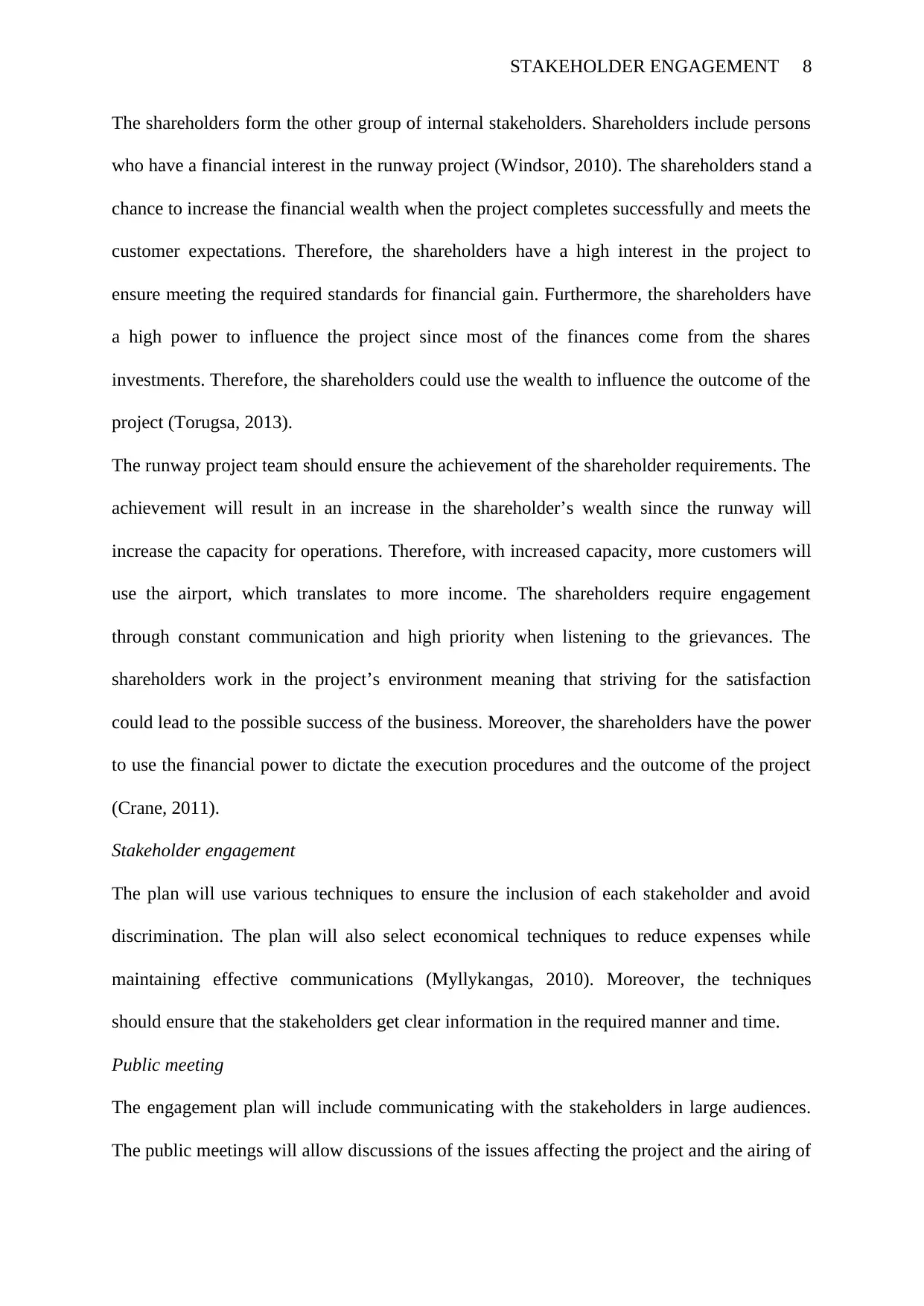
STAKEHOLDER ENGAGEMENT 8
The shareholders form the other group of internal stakeholders. Shareholders include persons
who have a financial interest in the runway project (Windsor, 2010). The shareholders stand a
chance to increase the financial wealth when the project completes successfully and meets the
customer expectations. Therefore, the shareholders have a high interest in the project to
ensure meeting the required standards for financial gain. Furthermore, the shareholders have
a high power to influence the project since most of the finances come from the shares
investments. Therefore, the shareholders could use the wealth to influence the outcome of the
project (Torugsa, 2013).
The runway project team should ensure the achievement of the shareholder requirements. The
achievement will result in an increase in the shareholder’s wealth since the runway will
increase the capacity for operations. Therefore, with increased capacity, more customers will
use the airport, which translates to more income. The shareholders require engagement
through constant communication and high priority when listening to the grievances. The
shareholders work in the project’s environment meaning that striving for the satisfaction
could lead to the possible success of the business. Moreover, the shareholders have the power
to use the financial power to dictate the execution procedures and the outcome of the project
(Crane, 2011).
Stakeholder engagement
The plan will use various techniques to ensure the inclusion of each stakeholder and avoid
discrimination. The plan will also select economical techniques to reduce expenses while
maintaining effective communications (Myllykangas, 2010). Moreover, the techniques
should ensure that the stakeholders get clear information in the required manner and time.
Public meeting
The engagement plan will include communicating with the stakeholders in large audiences.
The public meetings will allow discussions of the issues affecting the project and the airing of
The shareholders form the other group of internal stakeholders. Shareholders include persons
who have a financial interest in the runway project (Windsor, 2010). The shareholders stand a
chance to increase the financial wealth when the project completes successfully and meets the
customer expectations. Therefore, the shareholders have a high interest in the project to
ensure meeting the required standards for financial gain. Furthermore, the shareholders have
a high power to influence the project since most of the finances come from the shares
investments. Therefore, the shareholders could use the wealth to influence the outcome of the
project (Torugsa, 2013).
The runway project team should ensure the achievement of the shareholder requirements. The
achievement will result in an increase in the shareholder’s wealth since the runway will
increase the capacity for operations. Therefore, with increased capacity, more customers will
use the airport, which translates to more income. The shareholders require engagement
through constant communication and high priority when listening to the grievances. The
shareholders work in the project’s environment meaning that striving for the satisfaction
could lead to the possible success of the business. Moreover, the shareholders have the power
to use the financial power to dictate the execution procedures and the outcome of the project
(Crane, 2011).
Stakeholder engagement
The plan will use various techniques to ensure the inclusion of each stakeholder and avoid
discrimination. The plan will also select economical techniques to reduce expenses while
maintaining effective communications (Myllykangas, 2010). Moreover, the techniques
should ensure that the stakeholders get clear information in the required manner and time.
Public meeting
The engagement plan will include communicating with the stakeholders in large audiences.
The public meetings will allow discussions of the issues affecting the project and the airing of
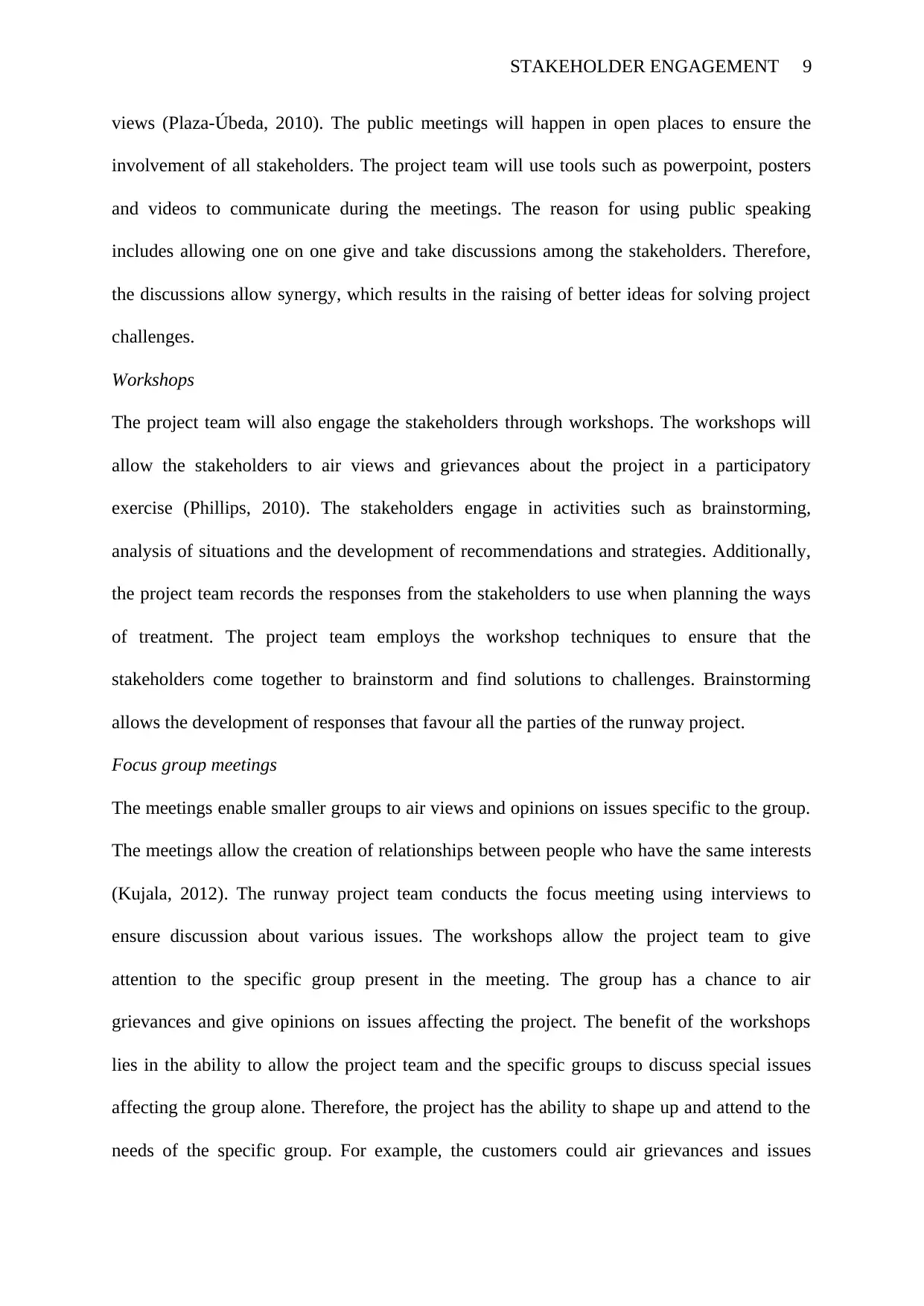
STAKEHOLDER ENGAGEMENT 9
views (Plaza-Úbeda, 2010). The public meetings will happen in open places to ensure the
involvement of all stakeholders. The project team will use tools such as powerpoint, posters
and videos to communicate during the meetings. The reason for using public speaking
includes allowing one on one give and take discussions among the stakeholders. Therefore,
the discussions allow synergy, which results in the raising of better ideas for solving project
challenges.
Workshops
The project team will also engage the stakeholders through workshops. The workshops will
allow the stakeholders to air views and grievances about the project in a participatory
exercise (Phillips, 2010). The stakeholders engage in activities such as brainstorming,
analysis of situations and the development of recommendations and strategies. Additionally,
the project team records the responses from the stakeholders to use when planning the ways
of treatment. The project team employs the workshop techniques to ensure that the
stakeholders come together to brainstorm and find solutions to challenges. Brainstorming
allows the development of responses that favour all the parties of the runway project.
Focus group meetings
The meetings enable smaller groups to air views and opinions on issues specific to the group.
The meetings allow the creation of relationships between people who have the same interests
(Kujala, 2012). The runway project team conducts the focus meeting using interviews to
ensure discussion about various issues. The workshops allow the project team to give
attention to the specific group present in the meeting. The group has a chance to air
grievances and give opinions on issues affecting the project. The benefit of the workshops
lies in the ability to allow the project team and the specific groups to discuss special issues
affecting the group alone. Therefore, the project has the ability to shape up and attend to the
needs of the specific group. For example, the customers could air grievances and issues
views (Plaza-Úbeda, 2010). The public meetings will happen in open places to ensure the
involvement of all stakeholders. The project team will use tools such as powerpoint, posters
and videos to communicate during the meetings. The reason for using public speaking
includes allowing one on one give and take discussions among the stakeholders. Therefore,
the discussions allow synergy, which results in the raising of better ideas for solving project
challenges.
Workshops
The project team will also engage the stakeholders through workshops. The workshops will
allow the stakeholders to air views and grievances about the project in a participatory
exercise (Phillips, 2010). The stakeholders engage in activities such as brainstorming,
analysis of situations and the development of recommendations and strategies. Additionally,
the project team records the responses from the stakeholders to use when planning the ways
of treatment. The project team employs the workshop techniques to ensure that the
stakeholders come together to brainstorm and find solutions to challenges. Brainstorming
allows the development of responses that favour all the parties of the runway project.
Focus group meetings
The meetings enable smaller groups to air views and opinions on issues specific to the group.
The meetings allow the creation of relationships between people who have the same interests
(Kujala, 2012). The runway project team conducts the focus meeting using interviews to
ensure discussion about various issues. The workshops allow the project team to give
attention to the specific group present in the meeting. The group has a chance to air
grievances and give opinions on issues affecting the project. The benefit of the workshops
lies in the ability to allow the project team and the specific groups to discuss special issues
affecting the group alone. Therefore, the project has the ability to shape up and attend to the
needs of the specific group. For example, the customers could air grievances and issues
⊘ This is a preview!⊘
Do you want full access?
Subscribe today to unlock all pages.

Trusted by 1+ million students worldwide

STAKEHOLDER ENGAGEMENT 10
affecting the project that the government officials do not care about. Moreover, the
workshops allow equality in the treatment of stakeholders due to the giving of equal
opportunities to air grievances (Kujala, 2012).
Roundtable discussions
The runway project team will engage the stakeholders using roundtable discussion. The
discussions use pre-set questions or discussion topics to facilitate the conversations (Liu,
2013). The roundtable discussions allow all the members to have an equal chance to
participate in the project’s progress. The persons have the right to push for the
implementation of ideas that could favour the group available in the roundtable discussions.
The reason for the runway project to engage the stakeholders through round table discussions
include the ability to collect ideas during a give and take process. The groups have mutual
discussions that lead to the achievement of objectives.
Engagement timelines
Stakeholder group Time of engagement
Government officials (includes the ministers
for finance, tourism, infrastructure, transport
and economic development.)
Design phase
Implementation phase
Local communities Design phase
Implementation phase
Monitoring and evaluation phase
Project personnel Design phase
Implementation phase
Monitoring and evaluation phase
Customers Design phase
Implementation phase
Suppliers Design phase
Implementation phase
Shareholders Design phase
Implementation phase
Monitoring and evaluation phase
Timeline of the various components
Component Timing
Preparation of disclosures and consultations 1.1.2018
Disclosure process 1.4.2018
affecting the project that the government officials do not care about. Moreover, the
workshops allow equality in the treatment of stakeholders due to the giving of equal
opportunities to air grievances (Kujala, 2012).
Roundtable discussions
The runway project team will engage the stakeholders using roundtable discussion. The
discussions use pre-set questions or discussion topics to facilitate the conversations (Liu,
2013). The roundtable discussions allow all the members to have an equal chance to
participate in the project’s progress. The persons have the right to push for the
implementation of ideas that could favour the group available in the roundtable discussions.
The reason for the runway project to engage the stakeholders through round table discussions
include the ability to collect ideas during a give and take process. The groups have mutual
discussions that lead to the achievement of objectives.
Engagement timelines
Stakeholder group Time of engagement
Government officials (includes the ministers
for finance, tourism, infrastructure, transport
and economic development.)
Design phase
Implementation phase
Local communities Design phase
Implementation phase
Monitoring and evaluation phase
Project personnel Design phase
Implementation phase
Monitoring and evaluation phase
Customers Design phase
Implementation phase
Suppliers Design phase
Implementation phase
Shareholders Design phase
Implementation phase
Monitoring and evaluation phase
Timeline of the various components
Component Timing
Preparation of disclosures and consultations 1.1.2018
Disclosure process 1.4.2018
Paraphrase This Document
Need a fresh take? Get an instant paraphrase of this document with our AI Paraphraser
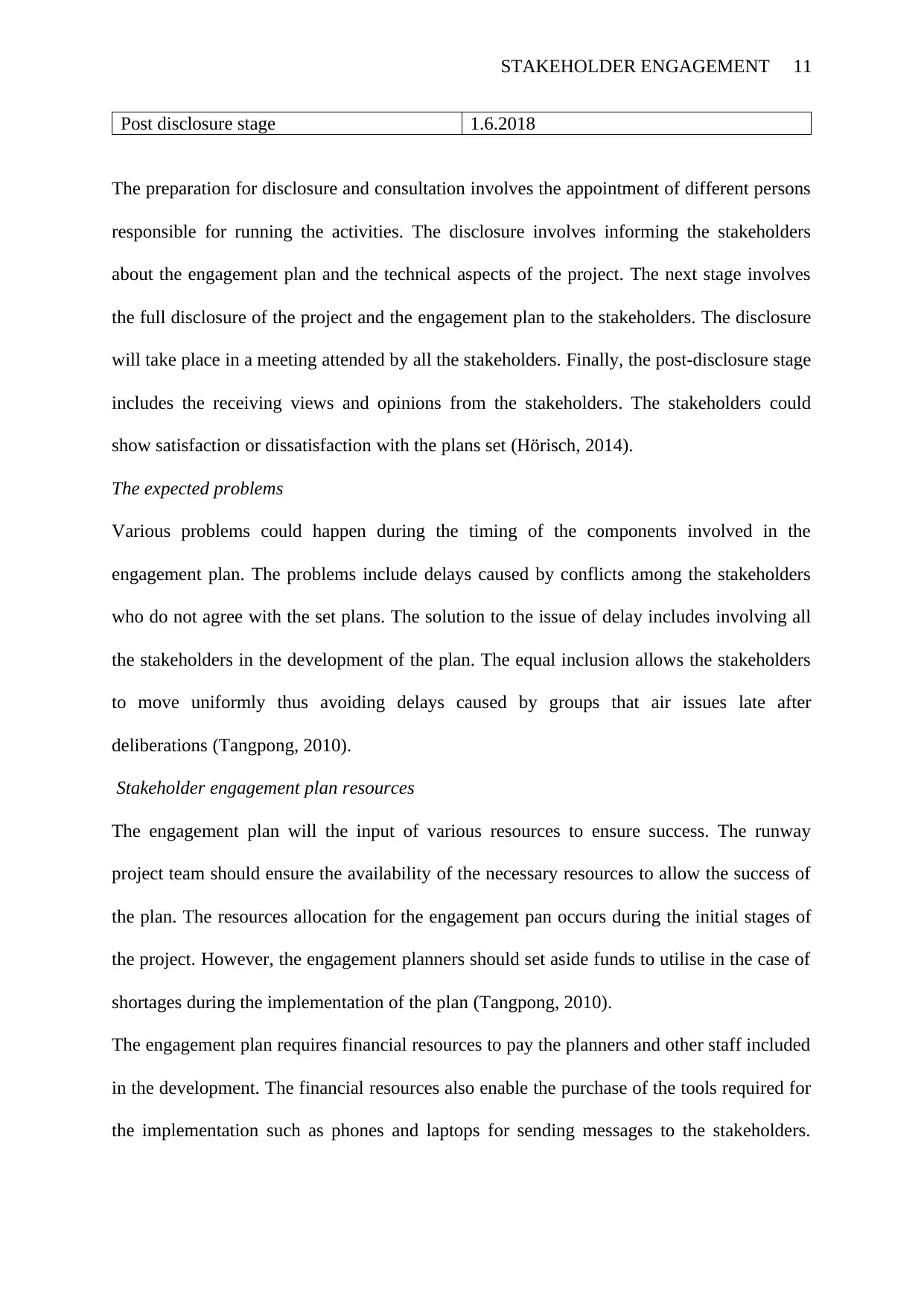
STAKEHOLDER ENGAGEMENT 11
Post disclosure stage 1.6.2018
The preparation for disclosure and consultation involves the appointment of different persons
responsible for running the activities. The disclosure involves informing the stakeholders
about the engagement plan and the technical aspects of the project. The next stage involves
the full disclosure of the project and the engagement plan to the stakeholders. The disclosure
will take place in a meeting attended by all the stakeholders. Finally, the post-disclosure stage
includes the receiving views and opinions from the stakeholders. The stakeholders could
show satisfaction or dissatisfaction with the plans set (Hörisch, 2014).
The expected problems
Various problems could happen during the timing of the components involved in the
engagement plan. The problems include delays caused by conflicts among the stakeholders
who do not agree with the set plans. The solution to the issue of delay includes involving all
the stakeholders in the development of the plan. The equal inclusion allows the stakeholders
to move uniformly thus avoiding delays caused by groups that air issues late after
deliberations (Tangpong, 2010).
Stakeholder engagement plan resources
The engagement plan will the input of various resources to ensure success. The runway
project team should ensure the availability of the necessary resources to allow the success of
the plan. The resources allocation for the engagement pan occurs during the initial stages of
the project. However, the engagement planners should set aside funds to utilise in the case of
shortages during the implementation of the plan (Tangpong, 2010).
The engagement plan requires financial resources to pay the planners and other staff included
in the development. The financial resources also enable the purchase of the tools required for
the implementation such as phones and laptops for sending messages to the stakeholders.
Post disclosure stage 1.6.2018
The preparation for disclosure and consultation involves the appointment of different persons
responsible for running the activities. The disclosure involves informing the stakeholders
about the engagement plan and the technical aspects of the project. The next stage involves
the full disclosure of the project and the engagement plan to the stakeholders. The disclosure
will take place in a meeting attended by all the stakeholders. Finally, the post-disclosure stage
includes the receiving views and opinions from the stakeholders. The stakeholders could
show satisfaction or dissatisfaction with the plans set (Hörisch, 2014).
The expected problems
Various problems could happen during the timing of the components involved in the
engagement plan. The problems include delays caused by conflicts among the stakeholders
who do not agree with the set plans. The solution to the issue of delay includes involving all
the stakeholders in the development of the plan. The equal inclusion allows the stakeholders
to move uniformly thus avoiding delays caused by groups that air issues late after
deliberations (Tangpong, 2010).
Stakeholder engagement plan resources
The engagement plan will the input of various resources to ensure success. The runway
project team should ensure the availability of the necessary resources to allow the success of
the plan. The resources allocation for the engagement pan occurs during the initial stages of
the project. However, the engagement planners should set aside funds to utilise in the case of
shortages during the implementation of the plan (Tangpong, 2010).
The engagement plan requires financial resources to pay the planners and other staff included
in the development. The financial resources also enable the purchase of the tools required for
the implementation such as phones and laptops for sending messages to the stakeholders.
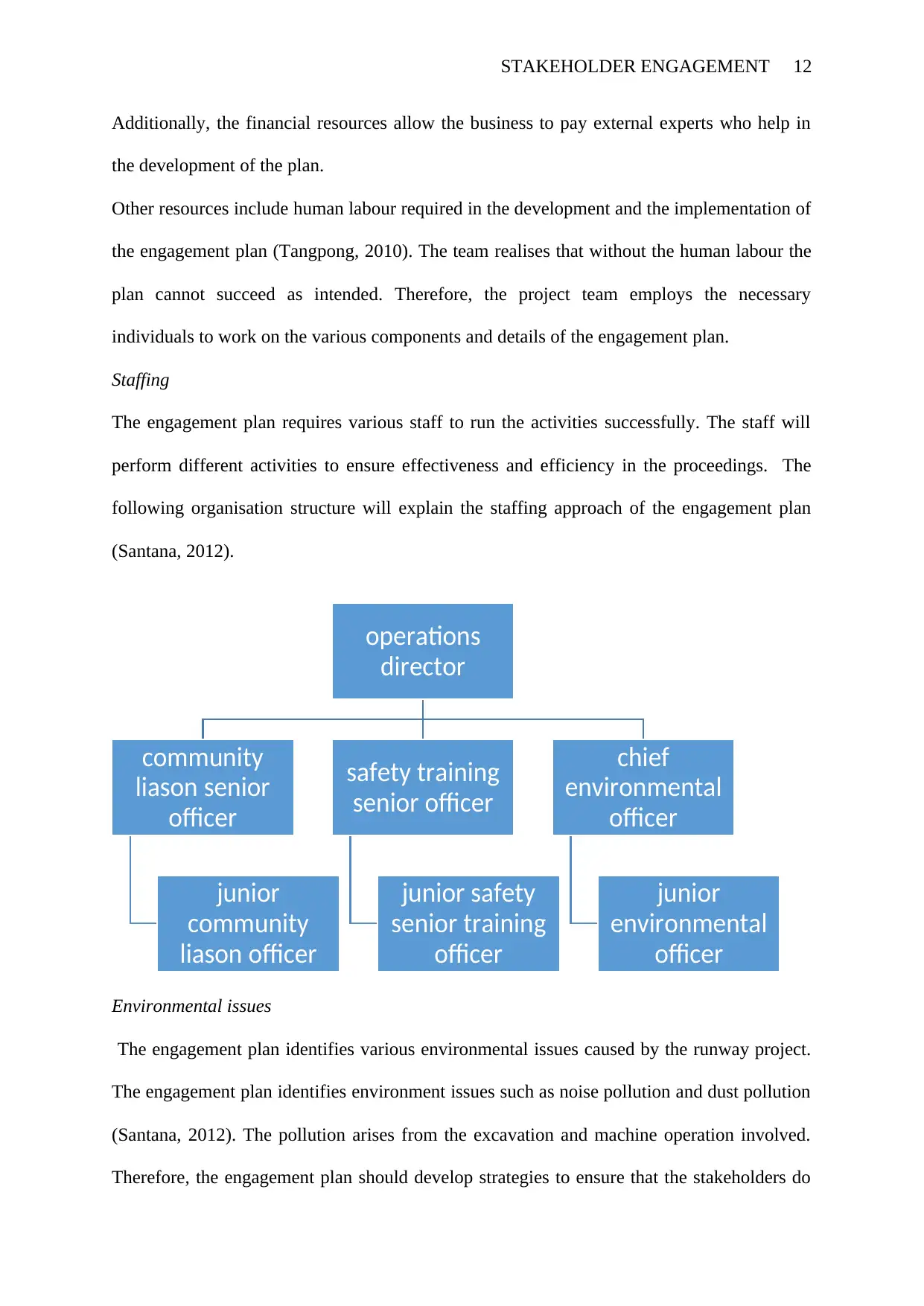
STAKEHOLDER ENGAGEMENT 12
Additionally, the financial resources allow the business to pay external experts who help in
the development of the plan.
Other resources include human labour required in the development and the implementation of
the engagement plan (Tangpong, 2010). The team realises that without the human labour the
plan cannot succeed as intended. Therefore, the project team employs the necessary
individuals to work on the various components and details of the engagement plan.
Staffing
The engagement plan requires various staff to run the activities successfully. The staff will
perform different activities to ensure effectiveness and efficiency in the proceedings. The
following organisation structure will explain the staffing approach of the engagement plan
(Santana, 2012).
Environmental issues
The engagement plan identifies various environmental issues caused by the runway project.
The engagement plan identifies environment issues such as noise pollution and dust pollution
(Santana, 2012). The pollution arises from the excavation and machine operation involved.
Therefore, the engagement plan should develop strategies to ensure that the stakeholders do
operations
director
community
liason senior
officer
junior
community
liason officer
safety training
senior officer
junior safety
senior training
officer
chief
environmental
officer
junior
environmental
officer
Additionally, the financial resources allow the business to pay external experts who help in
the development of the plan.
Other resources include human labour required in the development and the implementation of
the engagement plan (Tangpong, 2010). The team realises that without the human labour the
plan cannot succeed as intended. Therefore, the project team employs the necessary
individuals to work on the various components and details of the engagement plan.
Staffing
The engagement plan requires various staff to run the activities successfully. The staff will
perform different activities to ensure effectiveness and efficiency in the proceedings. The
following organisation structure will explain the staffing approach of the engagement plan
(Santana, 2012).
Environmental issues
The engagement plan identifies various environmental issues caused by the runway project.
The engagement plan identifies environment issues such as noise pollution and dust pollution
(Santana, 2012). The pollution arises from the excavation and machine operation involved.
Therefore, the engagement plan should develop strategies to ensure that the stakeholders do
operations
director
community
liason senior
officer
junior
community
liason officer
safety training
senior officer
junior safety
senior training
officer
chief
environmental
officer
junior
environmental
officer
⊘ This is a preview!⊘
Do you want full access?
Subscribe today to unlock all pages.

Trusted by 1+ million students worldwide
1 out of 19
Related Documents
Your All-in-One AI-Powered Toolkit for Academic Success.
+13062052269
info@desklib.com
Available 24*7 on WhatsApp / Email
![[object Object]](/_next/static/media/star-bottom.7253800d.svg)
Unlock your academic potential
Copyright © 2020–2025 A2Z Services. All Rights Reserved. Developed and managed by ZUCOL.




